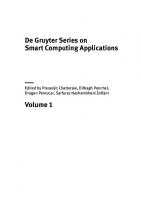Green Computing in Smart Cities: Simulation and Techniques 3030481409, 9783030481407
The book collects the latest research and thinking from international experts on green computing and the smart city. The
390 105 6MB
English Pages 218 [214] Year 2020
Table of contents :
Preface
Acknowledgements
Contents
The Modern Way for Virtual Machine Placement and Scalable Technique for Reduction of Carbon in Green Combined Cloud Datacenter
1 Introduction
2 Literature Review
2.1 The Autonomic Computing Paradigm and Maturity Levels
3 Cloud Computing Status with Green Computing
4 Green Cloud Environment
5 Energy-Efficient Cloud Environment
6 Energy Profiling
7 Energy-Inefficient Cloud Environment with Green Computing—Model Development
8 Model Development
9 Challenges and Future Work
10 Conclusion
References
A Review: Recent Trends in Green Computing
1 Introduction
2 Defining Green Computing
3 Purpose of Green Computing
4 Methodologies to Green Computing for Smart Cities
5 Smart Power Grid
6 Green Cloud
7 Green Computing Algorithms
8 Algorithms and System for Power and Efficiency
9 Applications of Strategies
10 Energy-Saving Techniques
11 Green Software
12 Conclusion
References
Green Computing and Internet of Things for Smart Cities: Technologies, Challenges, and Implementation
1 Introduction
2 Internet of Things
2.1 IoT Architecture
3 Environmental Challenges in IoT Usage
3.1 Energy Consumption
3.2 Carbon Emission
3.3 Electronic Waste
4 Green Computing
4.1 The Concept of Green Computing
4.2 Implementation of Green Computing—IoT Perspective
4.3 Implementation of Green Computing—General Perspective
5 Conclusion
References
Designing a Smart City: Technologies, Challenges and Solutions
1 Introduction
1.1 Why Smart Cities
2 The Role of IoTs in a Smart City
2.1 Traffic Management
2.2 Water Supply Management
2.3 Transportation
2.4 Energy Efficiency
2.5 Improving Public Safety
2.6 Wireless Sensor Networks
2.7 Functions of WSN in a Smart City
3 Challenges to Build Smart Cities
3.1 Security
3.2 Accountability
3.3 Connectivity Requirements
3.4 Interoperability
3.5 Open Data
3.6 Costs
4 Solutions
4.1 Information Communication and Technology (ICT)
4.2 Internet of Things (IoT)
4.3 Installing High Security Systems
4.4 Proper Planning
4.5 Optimizing Technology
5 Big Data in Smart City
6 LiDAR Technology in Smart Cities
7 Conclusion
References
Better Transmission of Information Focused on Green Computing Through Data Transmission Channels in Cloud Environments with Rayleigh Fading
1 Introduction
2 Cloud Computing
3 Green Computing
4 Green ICT
5 Discrete Events
5.1 Entities
5.2 AWGN Channel
5.3 DPSK and PSK
5.4 Rayleigh Fading
6 Methodology
7 Results and Discussion
8 Future Research Directions
9 Conclusion
References
Green ICT Communication, Networking and Data Processing
1 Introduction About Green Energy and WSN
2 Green Energy Efficient Clustering Data Transmission Model
2.1 Introduction
2.2 Green Efficient Clustering Techniques
2.3 Green Energy Adapting Model Architecture for WSN
3 An Energy Efficient Secured Data Transmission Model for WSN
3.1 Introduction
3.2 Secure Access Control and Security Algorithm
3.3 Green Energy Adaptable Secure Model Architecture for Hostile WSN
4 Green Energy Efficient Data Communication Model for Intelligent Surveillance System
4.1 Introduction
4.2 Collision Free Data Communication
4.3 Duplicate Video Identification for Green Energy Adaptation
4.4 Duplicate Video Check Methods Comparison to Find Green Energy Adapting Method
4.5 Camera Sensors in Surveillance System
4.6 Video Data Transmission in WSN
4.7 Green Energy Support Model Architecture for Surveillance System
5 Conclusion
References
Smart Education Using Mobile Green Cloud Enabled Platform and Services
1 Introduction
1.1 In This Day and Age
1.2 Revolution on Technology
1.3 Mobile Green—Cloud Computing Era
2 Literature Survey
3 Mobile Computing
3.1 Features of Mobile Computing
3.2 Enhanced Learning
3.3 Enhanced Learning
3.4 Significant in M-Education
4 Green Computing in Education
4.1 Introduction
4.2 Green Computing in Institutions
4.3 Digital Content Delivery
4.4 Methodologies and Approaches Towards Green Computing
4.5 To Design Green Software and the Corresponding Green Operating System (O/S)
5 Smart Education Using Cloud Enabled Platform and Devices
5.1 Education in Cloud
5.2 Smart Education Using Cloud Platform
6 Conclusion
References
Green ICT, Communication, Networking, and Data Processing
1 History
2 Green ICT
2.1 Aspects of Green ICT in DataCenters and Servers
2.2 Smart Grid System for Better Energy Management
2.3 Use of Latest Components as per Standards
2.4 Replacing Less Effective and Power-Hungry Grids
2.5 Cloud Computing-Based Green ICT
2.6 Practicing Cloud with Google Cloud Platform
3 Green Communication
3.1 Green Antennas
3.2 Fiber Optic Cable Communication
3.3 Cloud Computing-Based Communication
3.4 Practicing Cloud with Google Cloud Platform
4 Green Networking
4.1 Aspects of Green ICT in Network Architecture
4.2 Cloud Computing-Based Networking
5 Green Data-Processing
5.1 Expansion of Data in IoT-Driven World
5.2 Ecosystem of Big-Data
5.3 Cloud Computing Based Data Storing and Processing
6 Standards in IEEE
7 Greening Through IT a Revolution
8 Future Aspects
9 Conclusion
References
Impact of Green Computing in Shaping Education
1 Introduction
2 Green Computing
3 Need of Green Computing
3.1 Areas in the IT Sector Which Have Significant Effect on Environment
4 How Green Computing Can Change Education System
4.1 Virtual Entrance Assessments and Reports Released
4.2 Using Software to Evaluate Exam
4.3 Updation of Attendance, Marks, Other Details and Fees Payment Using Software
4.4 Using Online Brochures to Introduce Academic Institute
4.5 Using Online Brochures for Filling Application and Feedback Form
4.6 Maintaining Details of Staff Members and Course Details
4.7 In College Event Management
4.8 Making Account Department Cashless
5 Reducing E-Waste to Implement Green Computing
6 Implementing Green Computing by Reducing the Use of Printing Document
7 Save Electricity for Green Computing/Environment
8 Institutes Implementing
9 Conclusion and Future Scope
References
Energy Management and Monitoring Using IoT with CupCarbon Platform
1 Introduction on Energy Management
1.1 Overview of IoT
1.2 Simulation Tools of IoT
1.3 Outline of CupCarbon
1.4 Objective of the CupCarbon
2 IOT and CupCarbon Platform
2.1 Architecture of CupCarbon
2.2 Relationship Between IOT and CupCarbon
2.3 IoT and Road Network Connectivity
2.4 Implementation of IoT and CupCarbon in Road Network
3 Case Study: IOT Energy Management with CupCarbon
4 Challenges in IOT with CupCarbon
5 Conclusion
References
Preface
Acknowledgements
Contents
The Modern Way for Virtual Machine Placement and Scalable Technique for Reduction of Carbon in Green Combined Cloud Datacenter
1 Introduction
2 Literature Review
2.1 The Autonomic Computing Paradigm and Maturity Levels
3 Cloud Computing Status with Green Computing
4 Green Cloud Environment
5 Energy-Efficient Cloud Environment
6 Energy Profiling
7 Energy-Inefficient Cloud Environment with Green Computing—Model Development
8 Model Development
9 Challenges and Future Work
10 Conclusion
References
A Review: Recent Trends in Green Computing
1 Introduction
2 Defining Green Computing
3 Purpose of Green Computing
4 Methodologies to Green Computing for Smart Cities
5 Smart Power Grid
6 Green Cloud
7 Green Computing Algorithms
8 Algorithms and System for Power and Efficiency
9 Applications of Strategies
10 Energy-Saving Techniques
11 Green Software
12 Conclusion
References
Green Computing and Internet of Things for Smart Cities: Technologies, Challenges, and Implementation
1 Introduction
2 Internet of Things
2.1 IoT Architecture
3 Environmental Challenges in IoT Usage
3.1 Energy Consumption
3.2 Carbon Emission
3.3 Electronic Waste
4 Green Computing
4.1 The Concept of Green Computing
4.2 Implementation of Green Computing—IoT Perspective
4.3 Implementation of Green Computing—General Perspective
5 Conclusion
References
Designing a Smart City: Technologies, Challenges and Solutions
1 Introduction
1.1 Why Smart Cities
2 The Role of IoTs in a Smart City
2.1 Traffic Management
2.2 Water Supply Management
2.3 Transportation
2.4 Energy Efficiency
2.5 Improving Public Safety
2.6 Wireless Sensor Networks
2.7 Functions of WSN in a Smart City
3 Challenges to Build Smart Cities
3.1 Security
3.2 Accountability
3.3 Connectivity Requirements
3.4 Interoperability
3.5 Open Data
3.6 Costs
4 Solutions
4.1 Information Communication and Technology (ICT)
4.2 Internet of Things (IoT)
4.3 Installing High Security Systems
4.4 Proper Planning
4.5 Optimizing Technology
5 Big Data in Smart City
6 LiDAR Technology in Smart Cities
7 Conclusion
References
Better Transmission of Information Focused on Green Computing Through Data Transmission Channels in Cloud Environments with Rayleigh Fading
1 Introduction
2 Cloud Computing
3 Green Computing
4 Green ICT
5 Discrete Events
5.1 Entities
5.2 AWGN Channel
5.3 DPSK and PSK
5.4 Rayleigh Fading
6 Methodology
7 Results and Discussion
8 Future Research Directions
9 Conclusion
References
Green ICT Communication, Networking and Data Processing
1 Introduction About Green Energy and WSN
2 Green Energy Efficient Clustering Data Transmission Model
2.1 Introduction
2.2 Green Efficient Clustering Techniques
2.3 Green Energy Adapting Model Architecture for WSN
3 An Energy Efficient Secured Data Transmission Model for WSN
3.1 Introduction
3.2 Secure Access Control and Security Algorithm
3.3 Green Energy Adaptable Secure Model Architecture for Hostile WSN
4 Green Energy Efficient Data Communication Model for Intelligent Surveillance System
4.1 Introduction
4.2 Collision Free Data Communication
4.3 Duplicate Video Identification for Green Energy Adaptation
4.4 Duplicate Video Check Methods Comparison to Find Green Energy Adapting Method
4.5 Camera Sensors in Surveillance System
4.6 Video Data Transmission in WSN
4.7 Green Energy Support Model Architecture for Surveillance System
5 Conclusion
References
Smart Education Using Mobile Green Cloud Enabled Platform and Services
1 Introduction
1.1 In This Day and Age
1.2 Revolution on Technology
1.3 Mobile Green—Cloud Computing Era
2 Literature Survey
3 Mobile Computing
3.1 Features of Mobile Computing
3.2 Enhanced Learning
3.3 Enhanced Learning
3.4 Significant in M-Education
4 Green Computing in Education
4.1 Introduction
4.2 Green Computing in Institutions
4.3 Digital Content Delivery
4.4 Methodologies and Approaches Towards Green Computing
4.5 To Design Green Software and the Corresponding Green Operating System (O/S)
5 Smart Education Using Cloud Enabled Platform and Devices
5.1 Education in Cloud
5.2 Smart Education Using Cloud Platform
6 Conclusion
References
Green ICT, Communication, Networking, and Data Processing
1 History
2 Green ICT
2.1 Aspects of Green ICT in DataCenters and Servers
2.2 Smart Grid System for Better Energy Management
2.3 Use of Latest Components as per Standards
2.4 Replacing Less Effective and Power-Hungry Grids
2.5 Cloud Computing-Based Green ICT
2.6 Practicing Cloud with Google Cloud Platform
3 Green Communication
3.1 Green Antennas
3.2 Fiber Optic Cable Communication
3.3 Cloud Computing-Based Communication
3.4 Practicing Cloud with Google Cloud Platform
4 Green Networking
4.1 Aspects of Green ICT in Network Architecture
4.2 Cloud Computing-Based Networking
5 Green Data-Processing
5.1 Expansion of Data in IoT-Driven World
5.2 Ecosystem of Big-Data
5.3 Cloud Computing Based Data Storing and Processing
6 Standards in IEEE
7 Greening Through IT a Revolution
8 Future Aspects
9 Conclusion
References
Impact of Green Computing in Shaping Education
1 Introduction
2 Green Computing
3 Need of Green Computing
3.1 Areas in the IT Sector Which Have Significant Effect on Environment
4 How Green Computing Can Change Education System
4.1 Virtual Entrance Assessments and Reports Released
4.2 Using Software to Evaluate Exam
4.3 Updation of Attendance, Marks, Other Details and Fees Payment Using Software
4.4 Using Online Brochures to Introduce Academic Institute
4.5 Using Online Brochures for Filling Application and Feedback Form
4.6 Maintaining Details of Staff Members and Course Details
4.7 In College Event Management
4.8 Making Account Department Cashless
5 Reducing E-Waste to Implement Green Computing
6 Implementing Green Computing by Reducing the Use of Printing Document
7 Save Electricity for Green Computing/Environment
8 Institutes Implementing
9 Conclusion and Future Scope
References
Energy Management and Monitoring Using IoT with CupCarbon Platform
1 Introduction on Energy Management
1.1 Overview of IoT
1.2 Simulation Tools of IoT
1.3 Outline of CupCarbon
1.4 Objective of the CupCarbon
2 IOT and CupCarbon Platform
2.1 Architecture of CupCarbon
2.2 Relationship Between IOT and CupCarbon
2.3 IoT and Road Network Connectivity
2.4 Implementation of IoT and CupCarbon in Road Network
3 Case Study: IOT Energy Management with CupCarbon
4 Challenges in IOT with CupCarbon
5 Conclusion
References

- Author / Uploaded
- Balamurugan Balusamy
- Naveen Chilamkurti
- Seifedine Kadry
- Similar Topics
- Technique
- Energy: Renewable Energy
![Green Computing in Smart Cities: Simulation and Techniques [1 ed.]
9783030481407, 9783030481414](https://ebin.pub/img/200x200/green-computing-in-smart-cities-simulation-and-techniques-1nbsped-9783030481407-9783030481414.jpg)
![Green Computing for Sustainable Smart Cities [1 ed.]
1032483938, 9781032483931](https://ebin.pub/img/200x200/green-computing-for-sustainable-smart-cities-1nbsped-1032483938-9781032483931.jpg)







